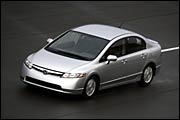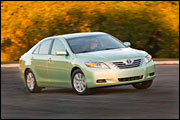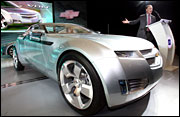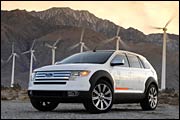The greenest way to get around? On your own two feet, of course, or on a bicycle, unicycle, skateboard, or public transit. But if you still find yourself in need of a car, these are some of the best green options on the market. If we zoomed right past your favorite eco-friendly auto, tell us in the comments section at the bottom of the page.
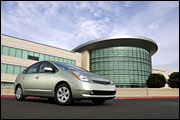
Toyota Prius
The best-selling Prius is synonymous with “hybrid” in many minds, and with good reason. More than 750,000 have been sold worldwide, and it’s the greenest mainstream car on the U.S. market in 2007, topped only by the natural-gas-powered Honda Civic GX in the authoritative Green Book survey. The Prius, which can travel short distances on its electric motor alone, gets 48 miles per gallon in the city and 45 on the highway, according to the U.S. Environmental Protection Agency’s new rating system (which gives lower but more accurate estimates than the old system). It’s also earned high ratings from California’s demanding emissions regulators. The instantly recognizable Prius starts at $22,175. If you have to get in line for one, it’ll be worth the wait.
Honda Civic Hybrid
This green Civic is another leading hybrid in the U.S., with many of the same features as the Prius — just not quite as many of them. The $22,600 Civic also operates somewhat differently from the Prius: the electric motor very rarely takes a solo turn, but rather is there to provide a boost to the 1.3-liter, four-cylinder engine. Its 40/45 mpg fuel economy, boosted by a continuously variable transmission, is commendable, as are its low emissions. Some consumers are disappointed that this hybrid looks like a conventional Civic, as people who own hybrids tend to want to flaunt their green values.
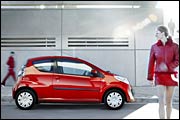
Peugeot 107, Citroën C1, and Toyota Aygo
In a feat of automotive cooperation, PSA Peugeot Citroën and Toyota built three different branded versions of the same efficient city car at a jointly owned factory they opened in the Czech Republic in 2005. Available on the European market, the three models — which differ only in name, price, interior trim fabric, and exterior detailing — boast fuel economy of 61.4 mpg for the gasoline-engine option. These compact four-seaters, available with either a gasoline or a diesel engine, are considered a competitor to the Smart car. Rumor has it that Toyota will introduce a version of the Aygo in the U.S. in 2008.

Tesla Roadster
This sleek electric sports car was unveiled in mid-2006, and its initial run of 100 cars sold out in three weeks. At a base price of $98,000, the high-end, lithium-battery-powered vehicle is only within reach of the rich, but its creators — including PayPal co-founder Elon Musk — plan to make an electric sedan that will sell for $50,000 to $65,000 within a few years, and a still cheaper model down the line. Meanwhile, the rest of us can only dream of sitting behind the wheel of the Roadster, which zooms from 0 to 60 in four seconds, boasts a top speed of 135, and has a range of more than 200 miles per charge. Named for inventor and electrical engineer Nikola Tesla, the car runs on a motor with one moving part, compared to the roughly 100 moving parts in a regular four-cylinder engine.
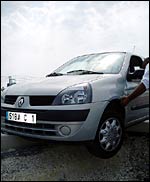
Renault eco2
Renault’s “eco2” label, introduced in May, assures customers that each vehicle bearing it has met several environmental standards: it does not exceed 140 g/km of carbon emissions and/or is biofuel compatible; it is 95 percent reusable by weight when it goes to the great garage in the sky; it contains at least 5 percent recycled plastics; and it was produced in a factory that continually strives to improve environmental performance. New vehicles in the eco2 line include a flex-fuel version of the Mégane, which will be Renault’s first vehicle in Europe capable of running on E85 ethanol, and the Clio, a popular subcompact. The eco2 initiative is part of the Renault Commitment 2009, in which the company pledges to curb its impacts on the planet and research alternative-fuel vehicles. All this at an affordable price? C’est bon.
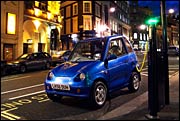
REVA G-Wiz
The teensy G-Wiz is a hit with British motorists who appreciate not only the electric car’s lack of emissions, but its exemption from London’s congestion charge and parking fees. Technically classified as a “quadricycle” in the U.K. and Europe, the vehicle — known in other countries simply as the REVA — is manufactured by a U.S.-Indian joint venture. It debuted in 2001, and there are now more than 2,000 on the road all over the world, with more than 800 of those in London. While the current model runs on a lead-acid battery, the manufacturer expects to upgrade to a lithium-ion battery in late 2007 or early 2008; it will charge more quickly, last longer, offer greater range, and better withstand temperature changes. Some officials have expressed concerns about the car’s safety, but supporters maintain that when the G-Wiz is driven at low speeds as intended, it is no less safe than any other car.
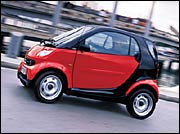
Smart Fortwo
A European standby, the Smart Fortwo has been rumored to be coming to America for a while now, but attempts to import it have been slowed by required safety and emissions upgrades. Still, three different two-seater models should be available in the U.S. next year, and 13,000 American drivers have paid a $99 deposit to reserve theirs. With a three-cylinder gasoline engine that gets 40-plus miles to the gallon and a top speed of 90 miles an hour, the DaimlerChrysler creation is a reasonable eco-option. And it’s a cinch to park: at 8.8 feet long, it’s three-quarters the size of a MINI Cooper. On top of that, a production process that ranges from installing recyclable dashboards to powder-coating exteriors (instead of using water-intensive, solvent-emitting paint) means this car leans green from start to finish.
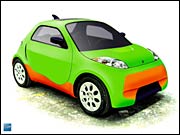
Obvio! 828
What is this cute three-seater? It’s Obvio! The teeny-tiny car — it’s mini-er than the MINI Cooper by nearly two feet — is a “trybrid,” able to run on any combination of gasoline, ethanol, or compressed natural gas. It has fuel economy of 29 mpg in the city and 40 on the highway, and also comes in an electric version with a range of up to 240 miles per charge. Made in Brazil, the Obvio! 828 is aimed at the hipster crowd, with its bright green and orange paint job, trendy flip-flops glued to the brake and gas pedals, and ability of the electric version to go from 0 to 60 in about 4.5 seconds. The manufacturers are also getting in on another hip trend, contributing a portion of each car’s purchase price to offset its carbon footprint. The Obvio! will be distributed in the U.S. by small, eco-friendly importer ZAP at a price of $14,000 for the trybrid model and $49,000 for the electric version. With 50,000 set to hit U.S. shores in 2008, it’s, like, totally obvio that this “pocket rocket” will be going far.
Toyota Camry Hybrid
Like the Prius, the new Camry hybrid actually runs wholly on its batteries at low speeds. Under the hood, its 2.4-liter, four-cylinder engine uses the Atkinson cycle for greater fuel efficiency. Add together the 147-horsepower gasoline engine and the 45-horsepower electric motor, and you’ve got a car that’s faster and bigger than the Prius and boasts a not-too-shabby 33/34 mpg. Like the Prius, the Camry is a relative bargain at $26,200, nearly $5,000 less than the competition, the performance-oriented Honda Accord Hybrid.
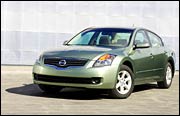
Nissan Altima Hybrid
This exemplary hybrid sedan is available only in California and a number of Northeastern U.S. states that have signed on to California’s stringent emission standards. It’s a mystery why Nissan doesn’t sell it everywhere, since reviewers who’ve been able to get behind the wheel have good things to say. Using technology purchased from Toyota, the Altima hybrid couples an electric motor with a 2.5-liter, 158-horsepower gasoline engine and a continuously variable transmission. It has the acceleration of a V-6 (eight seconds to 60 mph), 35/33 mpg fuel economy, and a 700-mile range. Nissan’s reluctance to dive into the market headfirst may have to do with CEO Carlos Ghosn, who said of hybrids in 2005, “They make a nice story, but they’re not a good business story yet because the value is lower than their costs.”
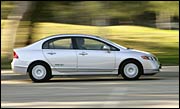
Honda Civic GX
The Civic GX, which runs on compressed natural gas, has been called the cleanest internal-combustion vehicle on earth by the U.S. EPA and won top honors in the Green Book rankings. Initially sold for commercial fleets, the Civic can now be purchased by individuals and refueled at home with a special appliance called Phill that connects to a gas line. Armed with slightly less horsepower than the regular Civic — and a smaller trunk due to the bigger gas tank — the GX isn’t perfection on wheels, but it’s not a bad start. On sale in California and New York, it also comes equipped with a handy federal tax credit.
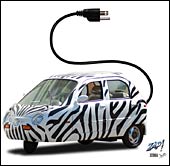
ZAP Xebra
It might not be the most powerful vehicle out there, or the most practical, but the ZAP Xebra gets points for style. The three-wheeled electric sedan — with its optional zebra-stripe paint job — averages about 25 miles per charge, and can hit a top speed of 40 miles per hour. A viable freeway option it ain’t, but you can’t beat the $10,000 price for getting around town without spewing a stew of emissions. The Xebra produces 98 percent fewer emissions than a gasoline car, even counting the power-plant emissions needed to produce the juice that runs it, according to ZAP, which plants trees for each Xebra sold.
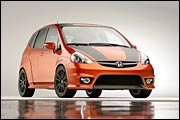
Honda Fit/Jazz
The tiny Fit looks novel to Americans, but as the Jazz it is well established in the Asian and European markets. Its upright, wheels-at-the-corners design looks like a Scion that somehow avoided the shotgun marriage with an SUV. Don’t expect barrels of torque or high-end acceleration, but with its low emissions and respectable fuel economy — 28 mpg in the city, 34 on the highway — the Fit is well worth considering. The $13,850 Fit can carry five adults and a modest amount of luggage: the 60/40-split rear seats fold flat, and the fronts fold, too, resulting in a fairly cramped and lumpy but serviceable makeshift bed.
Mazda MX-5 Miata
This whimsical sports car may seem like an odd choice for green warrior status, but consider that the venerable Miata gets 22 mpg in the city and 27 on the highway while keeping its air-polluting emissions relatively low. It scores high in the Green Book rankings, tying with the Toyota Highlander Hybrid on its overall green score. The two-liter, four-cylinder engine is a little rocket, docked only for requiring premium unleaded fuel. Think of the $21,180 Miata as the little car that could, almost single-handedly reviving the concept of the buzzy two-seater roadster. Another plus: there are owners’ clubs virtually everywhere, even in Singapore.
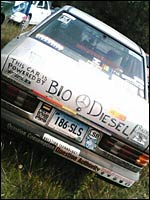
Biodiesel cars
Any diesel car can be made greener if you fill it up with biodiesel fuel. Refined biodiesel works in newer diesels without any vehicle modifications. And with a kit from companies like Greasecar, any diesel car can be adapted to burn 100 percent vegetable oil, which can be sourced and filtered from restaurants for a wholly recycled fuel. The resulting “grease” offers improved emissions and the chance to thumb your nose at fossil fuels; one study by the U.S. Department of Agriculture concluded that biodiesel made from soy produces 78 percent less carbon dioxide pollution than standard diesel. In 2006, 250 million gallons of biodiesel were sold in the U.S., but the widespread use of biodiesel is considered unlikely due to the limits of agricultural infrastructure. The National Biodiesel Board predicts that biofuels could displace only about 10 to 15 percent of current fossil-fuel use.
Runners-Up
Call these hot rods for a hot planet. These high-concept, high-efficiency cars aren’t on sale to the masses yet, but they’re something to look forward to down the road.
Chevy Volt
The ultra-sleek Volt promises to be a wholly new form of hybrid. GM has been showing off the concept car at auto shows, touting its theoretical capacity to get the equivalent of 100-plus miles per gallon and travel up to 640 miles on one tank of gas. Known as a “series” hybrid, its one-liter, turbo-charged gasoline engine is there just to keep the lithium-ion batteries charged and extend the car’s range. However, there are currently no available lithium-ion battery packs capable of delivering the performance GM engineers need, so don’t expect to see the Volt in showrooms before the end of the decade.
Ford HySeries Edge
It looks like a gas-guzzling SUV, but instead of a whompin’ V-8 under its hood, the HySeries Edge offers a zero emissions fuel-cell/electric-motor drivetrain. Bristling with new technology, this concept vehicle is built around a 336-volt lithium-ion battery pack. Fully charged, the batteries can carry the vehicle 25 miles, but the range is extended another 200 miles by an onboard fuel cell that kicks in when the batteries are 40 percent depleted. Ideally, if you run out of hydrogen you can simply recharge the batteries by plugging into the wall. There’s something of a modular concept here, because the fuel cell could be replaced by a small engine; in that case, it would be the conventional plug-in hybrid everyone’s talking about.
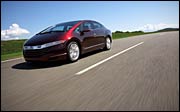
Honda FCX
The FCX, a fuel-cell concept car, is a hydrogen-powered zero-emissions vehicle with technology befitting a Back to the Future script — a fuel-cell stack, ultra-capacitor, and high-pressure hydrogen fuel tanks. The cars are prohibitively expensive to produce and thus unavailable to the masses for the time being, but, for purposes of publicity and testing, Honda has leased out a handful in Southern California and plans to make more available in 2008.

Tango T600
George Clooney was an early adopter, but the rest of us will have to wait for our Tangos. The startup that makes the tiny electric car is currently producing a batch of just 10 of the T600s, which will sell at the movie-star price of $108,000. The tandem two-seater is narrower than some motorcycles; as a result, say its ambitious creators, it is “doubling freeways” and “quadrupling parking.” The Tango is aimed at commuters, with conventional lead-acid batteries providing a relatively modest 80-mile range. (A longer range would be possible with higher-tech batteries, and the car can also be built with an internal combustion or fuel-cell engine.) Two more models, the T200 (expected to cost $39,900) and T100 ($18,700), are still on the drawing board, but you can put down a deposit to reserve yours today.
What’s your favorite green set of wheels? Tell us below in comments.
